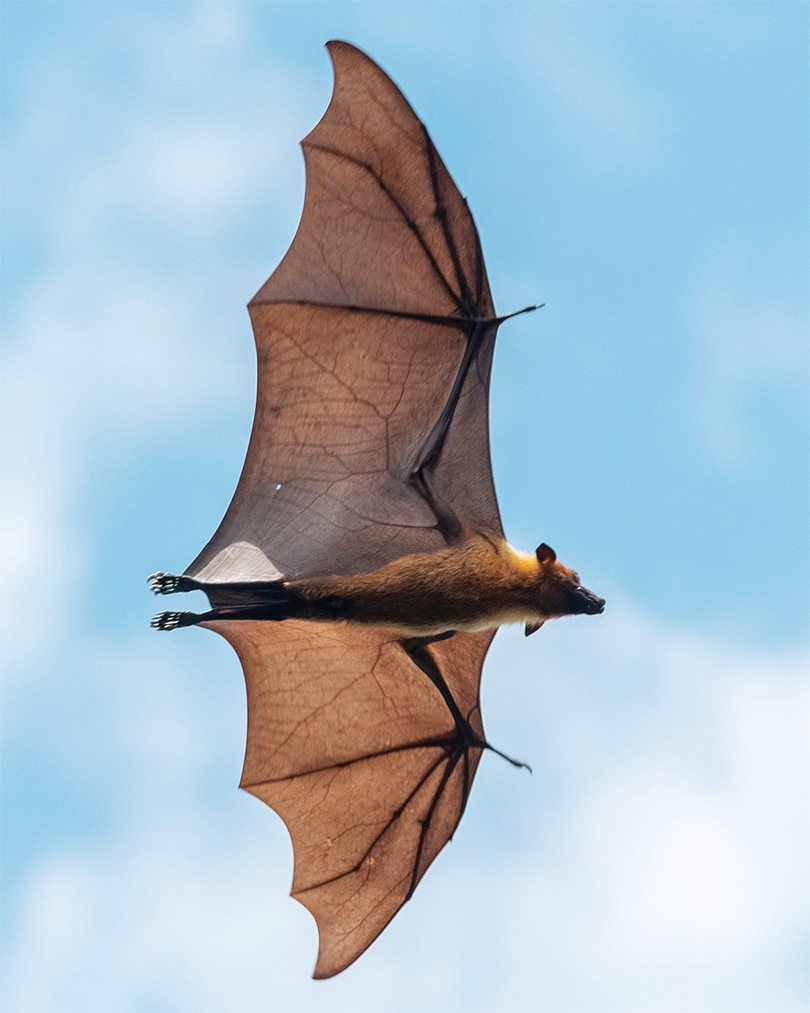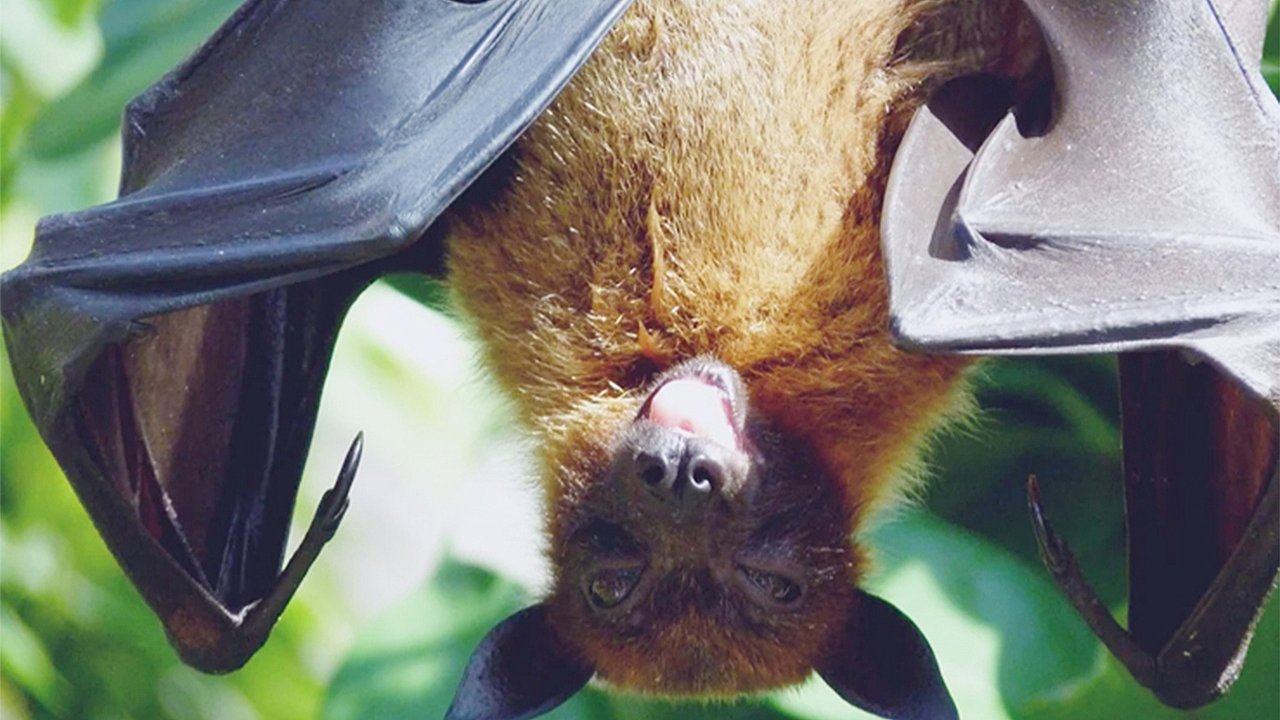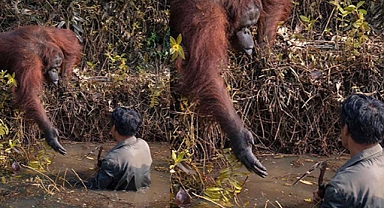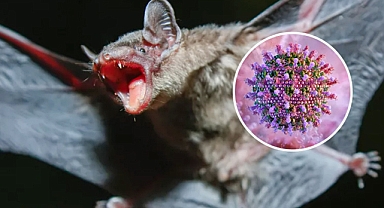The Enigmatic Giants of the Sky
The giant golden-crowned flying fox (Acerodon jubatus), also called the golden-capped fruit bat, is a mesmerizing megabat and one of the largest flying mammals on Earth. This species stands as a testament to the incredible biodiversity of the Philippines, where it resides, but sadly, it is endangered. Its enormous wingspan and unique appearance give it an almost mythical quality, leaving many stunned at its very existence. A Marvel of Nature’s Design
A Marvel of Nature’s Design
This extraordinary bat gets its name from the golden-yellow fur that crowns its head, in stark contrast to its dark, almost black body. Its size is equally astounding, with a wingspan of 1.5 to 1.7 meters (4 ft 10 in to 5 ft 7 in), and it weighs between 0.7 to 1.2 kilograms (1.5–2.6 lbs). These dimensions make the golden-crowned flying fox one of the largest bats, rivaled only by a few species of Pteropus, the flying foxes. Like other fruit bats, it lacks a tail and, when at rest, wraps its vast wings around itself like a cloak, giving the appearance of a creature from folklore.A Life Aloft: Behavior and Habitat
These bats are forest-dwelling creatures, spending most of their lives hidden in the dense canopy. Found at elevations ranging from sea level to 1,100 meters (3,600 feet), they embark on nightly foraging journeys of over 25 miles (40 km) in search of their favorite fruits, especially figs. They are elusive, avoiding human-inhabited areas, which makes studying them a challenge. One 2005 survey found no individuals in settled regions, confirming that they are forest obligates, meaning they thrive only in undisturbed wilderness.Silent Navigators: Flight Without Echolocation
Unlike microbats, megabats lack the ability to echolocate, except for the Egyptian fruit bat (Rousettus aegyptiacus), which uses tongue-clicks. The giant golden-crowned flying fox relies on keen eyesight and an exceptional sense of smell to navigate and find food. Scientists theorize that echolocation was lost in the Pteropodidae family due to the species’ larger size, which disrupted the efficient coupling between flight and echolocation—an energy-intensive process that only smaller bats could maintain.A Species Under Threat
Deforestation and hunting pose significant threats to the survival of this unique megabat. Their forest homes are being destroyed for agriculture and development, forcing them into smaller and more vulnerable areas. The Philippines has become a battleground for conservation, with efforts concentrated in areas like Subic Bay, a 14,000-acre (57 km²) protected zone. Local governments, particularly in Maitum, Sarangani, have launched campaigns to prevent the extinction of this species.Conservation Initiatives: A Ray of Hope
Several global organizations, including Bat Conservation International, the Wildlife Conservation Society, the World Wildlife Fund, and the Lubee Foundation, are working together to save the giant golden-crowned flying fox. These groups focus on research funding, habitat preservation, and public education to raise awareness. Subic Bay remains one of the few places where researchers can safely study these creatures, gathering vital data to support conservation.Giants of the Night
The giant golden-crowned flying fox exemplifies the breathtaking diversity of life on Earth—proof that creatures of legend can and do exist. However, its survival depends on swift and decisive conservation efforts. Protecting its forest habitat and discouraging illegal hunting are crucial steps toward ensuring that future generations can marvel at these majestic megabats.
The giant golden-crowned flying fox (Acerodon jubatus), also called the golden-capped fruit bat, is a mesmerizing megabat and one of the largest flying mammals on Earth. This species stands as a testament to the incredible biodiversity of the Philippines, where it resides, but sadly, it is endangered. Its enormous wingspan and unique appearance give it an almost mythical quality, leaving many stunned at its very existence.
 A Marvel of Nature’s Design
A Marvel of Nature’s DesignThis extraordinary bat gets its name from the golden-yellow fur that crowns its head, in stark contrast to its dark, almost black body. Its size is equally astounding, with a wingspan of 1.5 to 1.7 meters (4 ft 10 in to 5 ft 7 in), and it weighs between 0.7 to 1.2 kilograms (1.5–2.6 lbs). These dimensions make the golden-crowned flying fox one of the largest bats, rivaled only by a few species of Pteropus, the flying foxes. Like other fruit bats, it lacks a tail and, when at rest, wraps its vast wings around itself like a cloak, giving the appearance of a creature from folklore.A Life Aloft: Behavior and Habitat
These bats are forest-dwelling creatures, spending most of their lives hidden in the dense canopy. Found at elevations ranging from sea level to 1,100 meters (3,600 feet), they embark on nightly foraging journeys of over 25 miles (40 km) in search of their favorite fruits, especially figs. They are elusive, avoiding human-inhabited areas, which makes studying them a challenge. One 2005 survey found no individuals in settled regions, confirming that they are forest obligates, meaning they thrive only in undisturbed wilderness.Silent Navigators: Flight Without Echolocation
Unlike microbats, megabats lack the ability to echolocate, except for the Egyptian fruit bat (Rousettus aegyptiacus), which uses tongue-clicks. The giant golden-crowned flying fox relies on keen eyesight and an exceptional sense of smell to navigate and find food. Scientists theorize that echolocation was lost in the Pteropodidae family due to the species’ larger size, which disrupted the efficient coupling between flight and echolocation—an energy-intensive process that only smaller bats could maintain.A Species Under Threat
Deforestation and hunting pose significant threats to the survival of this unique megabat. Their forest homes are being destroyed for agriculture and development, forcing them into smaller and more vulnerable areas. The Philippines has become a battleground for conservation, with efforts concentrated in areas like Subic Bay, a 14,000-acre (57 km²) protected zone. Local governments, particularly in Maitum, Sarangani, have launched campaigns to prevent the extinction of this species.Conservation Initiatives: A Ray of Hope
Several global organizations, including Bat Conservation International, the Wildlife Conservation Society, the World Wildlife Fund, and the Lubee Foundation, are working together to save the giant golden-crowned flying fox. These groups focus on research funding, habitat preservation, and public education to raise awareness. Subic Bay remains one of the few places where researchers can safely study these creatures, gathering vital data to support conservation.Giants of the Night
The giant golden-crowned flying fox exemplifies the breathtaking diversity of life on Earth—proof that creatures of legend can and do exist. However, its survival depends on swift and decisive conservation efforts. Protecting its forest habitat and discouraging illegal hunting are crucial steps toward ensuring that future generations can marvel at these majestic megabats.










